Abstract
1. The secretion of vasopressin in response to haemorrhagic shock has been investigated in anaesthetized dogs.
2. The changes in the plasma concentrations of vasopressin were followed over a period of 5 hr, during which the arterial blood pressure was kept constant at 40 mm Hg. It was found that vasopressin concentration in plasma rose to a high peak shortly after the onset of shock and gradually declined thereafter. Five hours later, it was still 3·5 times higher than control. Re-transfusion of blood was followed by a return to control levels.
3. The clearance of vasopressin was calculated before and during shock in normal dogs and in dogs with experimental diabetes insipidus. Soon after the onset of shock, the clearance rate dropped to one quarter of its normal level but slowly recovered, returning to near control values at the fifth hour of shock. Clearance rates did not vary as a function of infusion rates, suggesting that there is no maximal transport rate for the removal of the hormone over the entire secretory range found in normal and hypotensive dogs.
4. From the clearance rates and from the plasma concentrations of endogenously secreted vasopressin it has been possible to calculate the approximate secretory rates of the hormone in response to shock. Secretion rose to a very high level, some 40 times greater than control, at the onset of shock. This was followed by a fairly constant secretory plateau. At the fifth hour of shock secretion was 3·5 times higher than control.
5. The half-life of vasopressin was measured in normal and hypotensive dogs. Control measurements confirm the generally accepted value of approximately 5 min. The half-life was significantly higher in the early stage of shock, but returned to control values in the later stage.
6. Haemorrhage experiments performed in normal and diabetic dogs suggest that vasopressin may play a part in the development of irreversible haemorrhagic shock: all normal animals died within a few hours of retransfusion, whereas four out of eight diabetic dogs similarly treated survived a 24 hr observation period. In a separate set of experiments, eight diabetic dogs were subjected to the haemorrhage procedure while receiving a constant infusion of vasopressin: only two of these survived. Surviving dogs showed none of the characteristic lesions of irreversible haemorrhagic shock.
Full text
PDF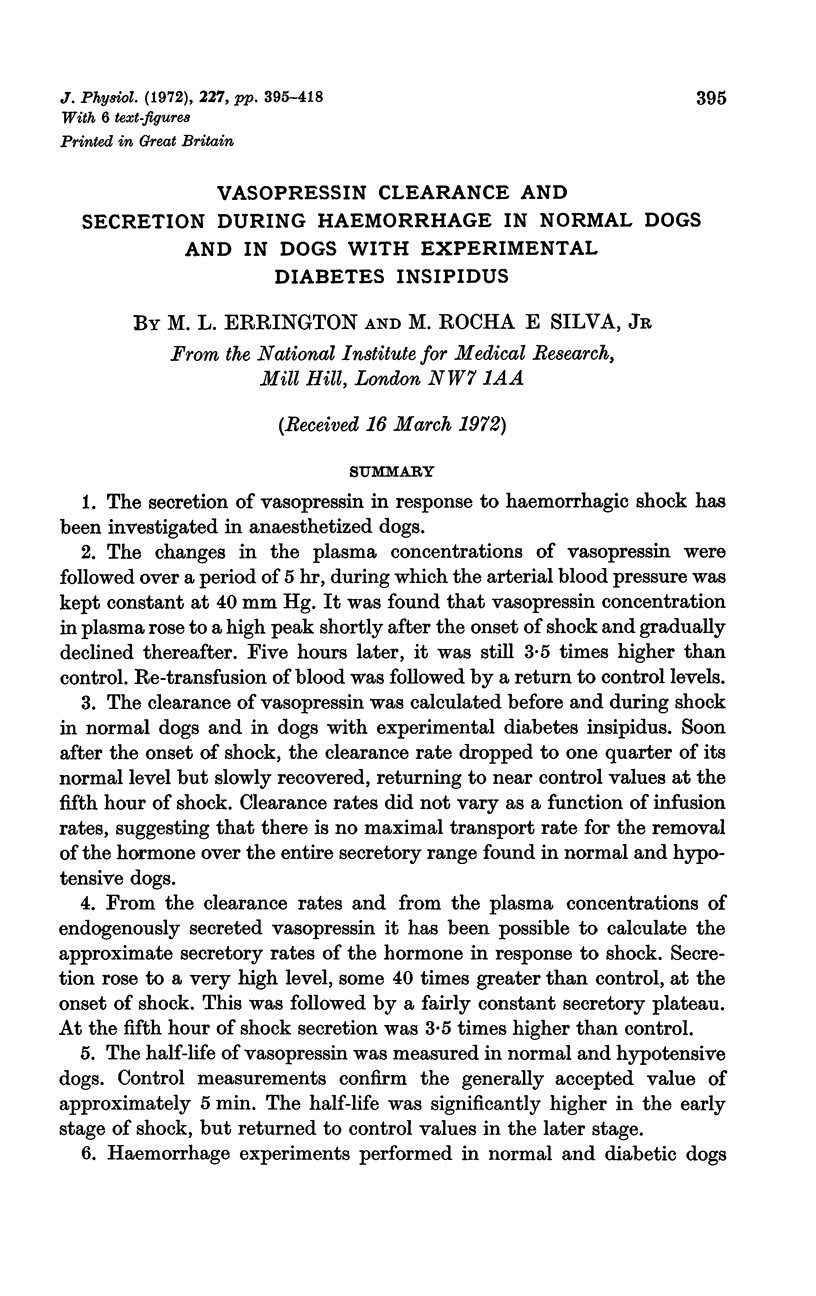
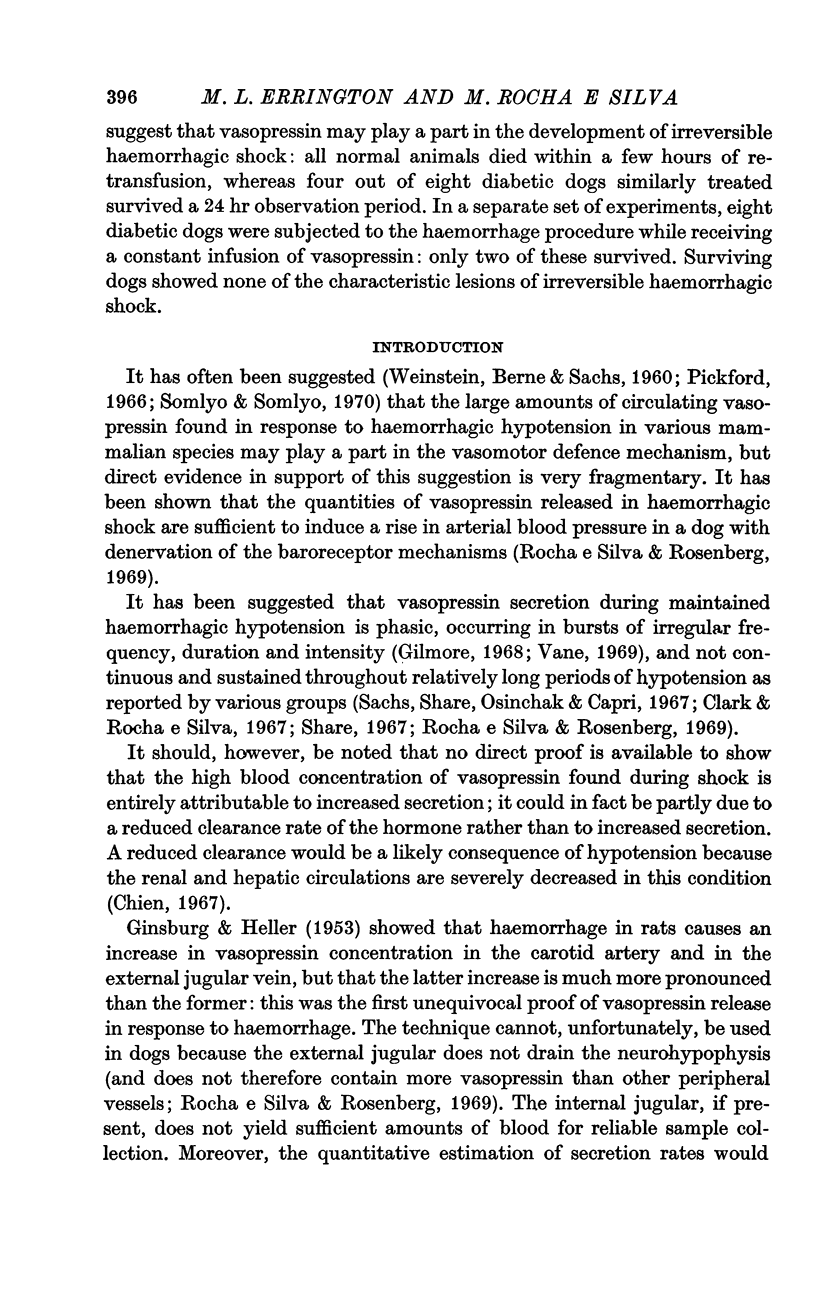
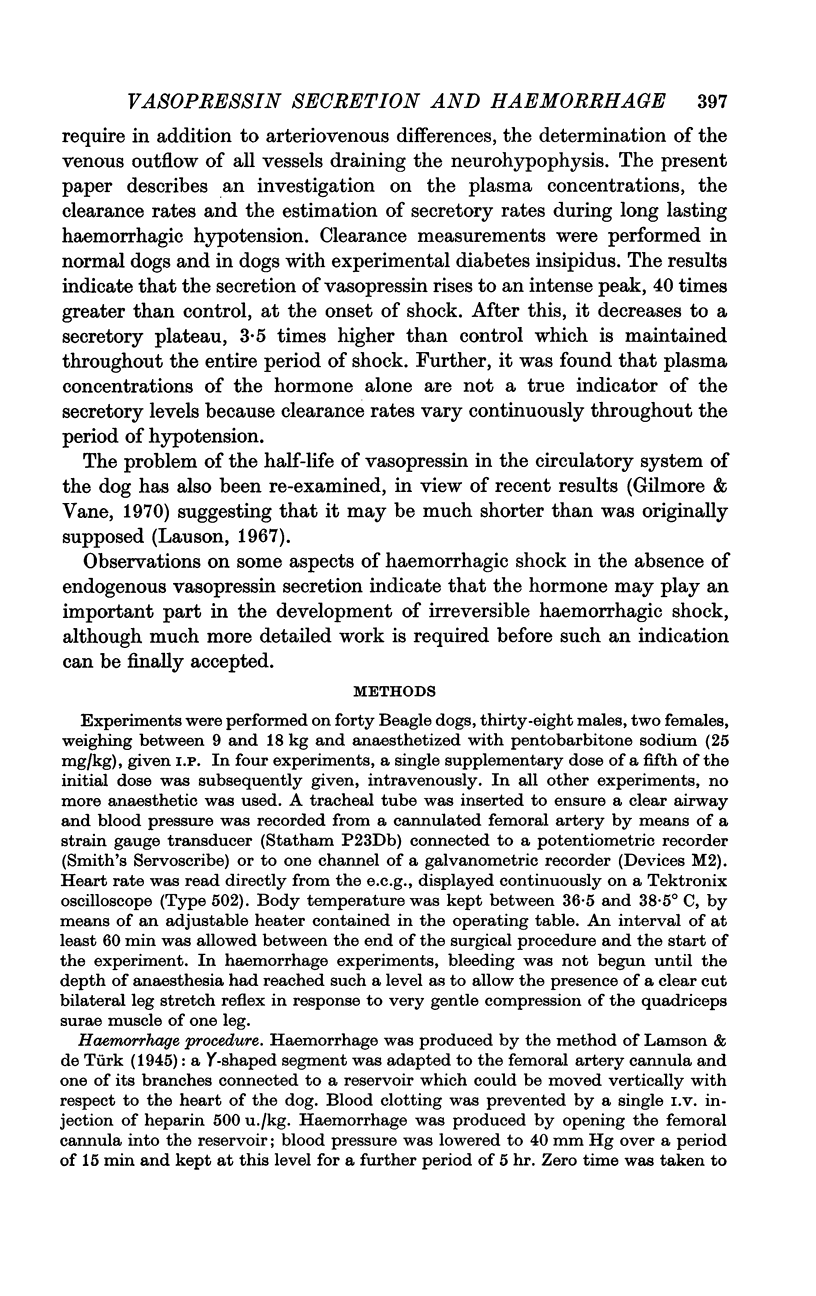

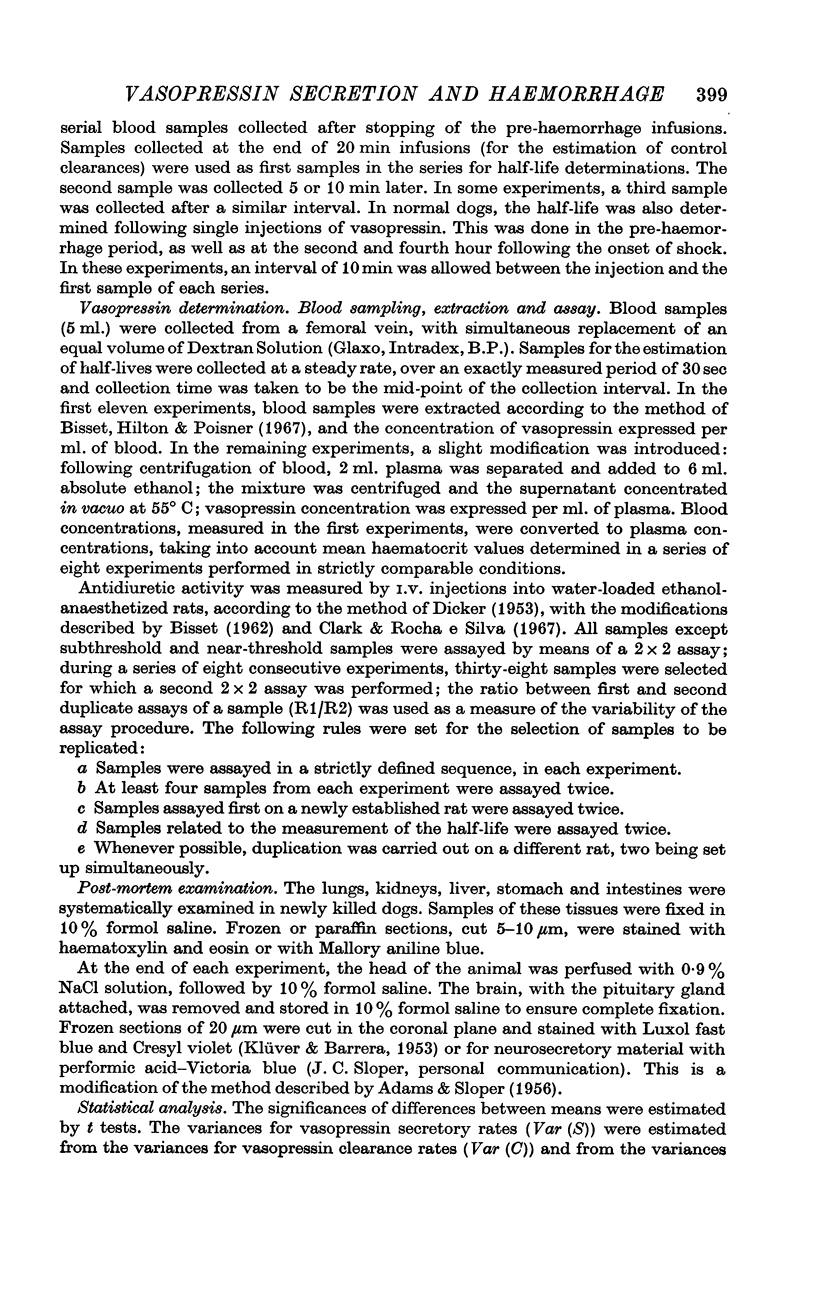
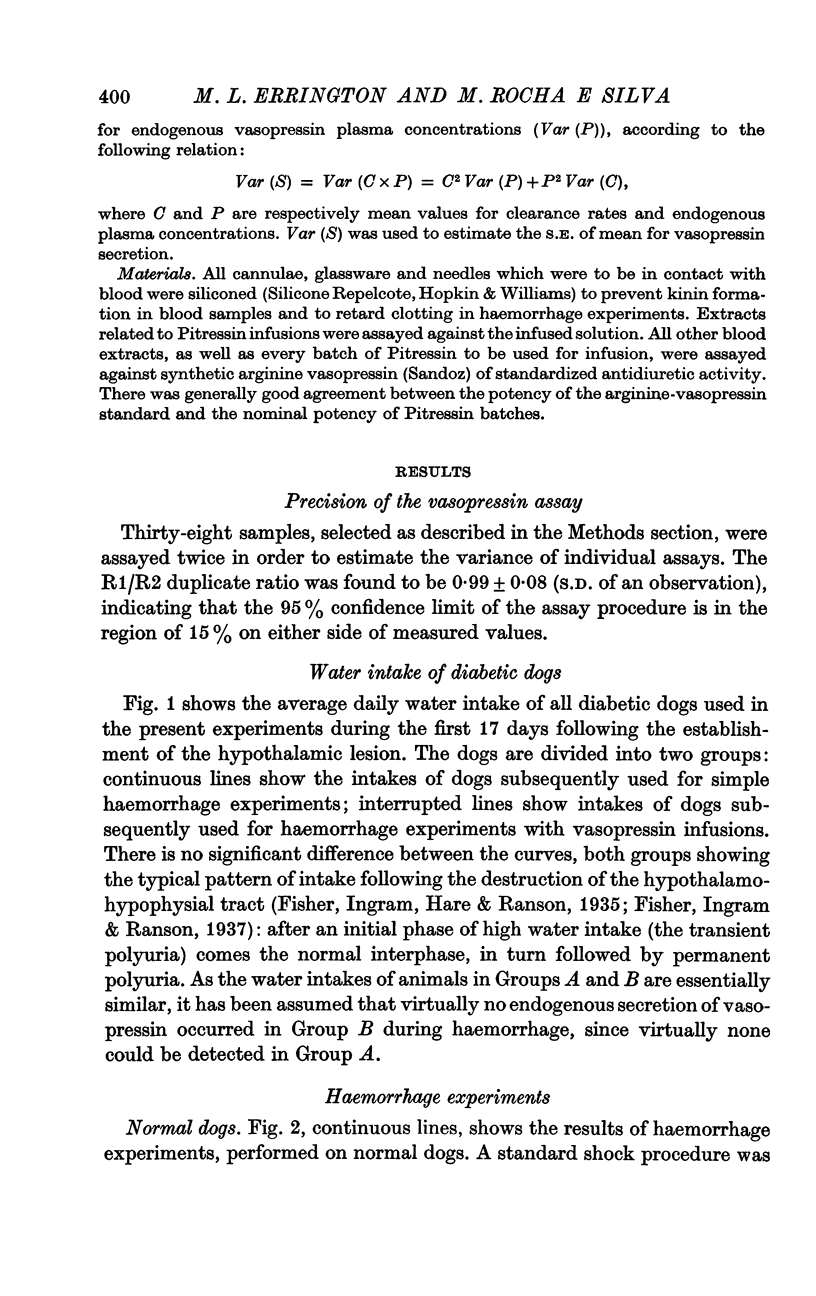
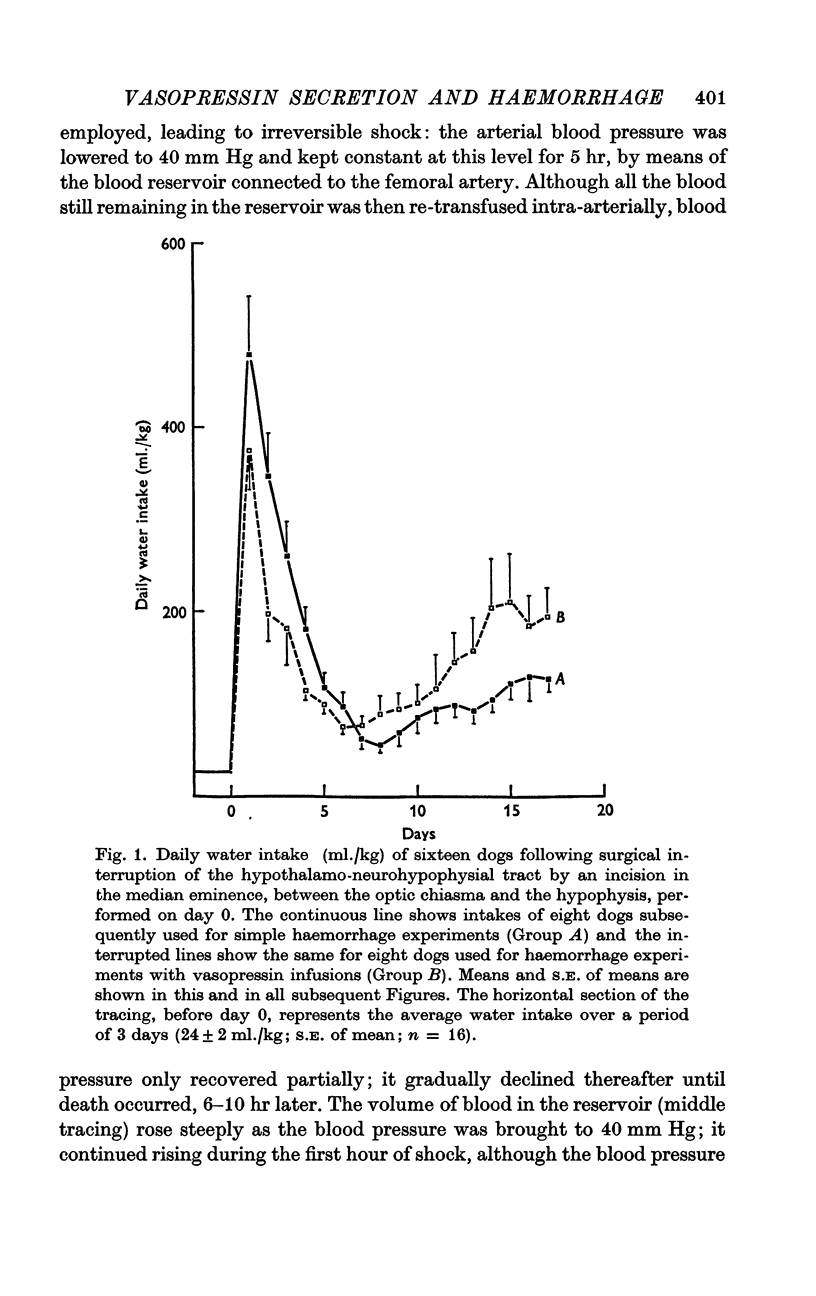
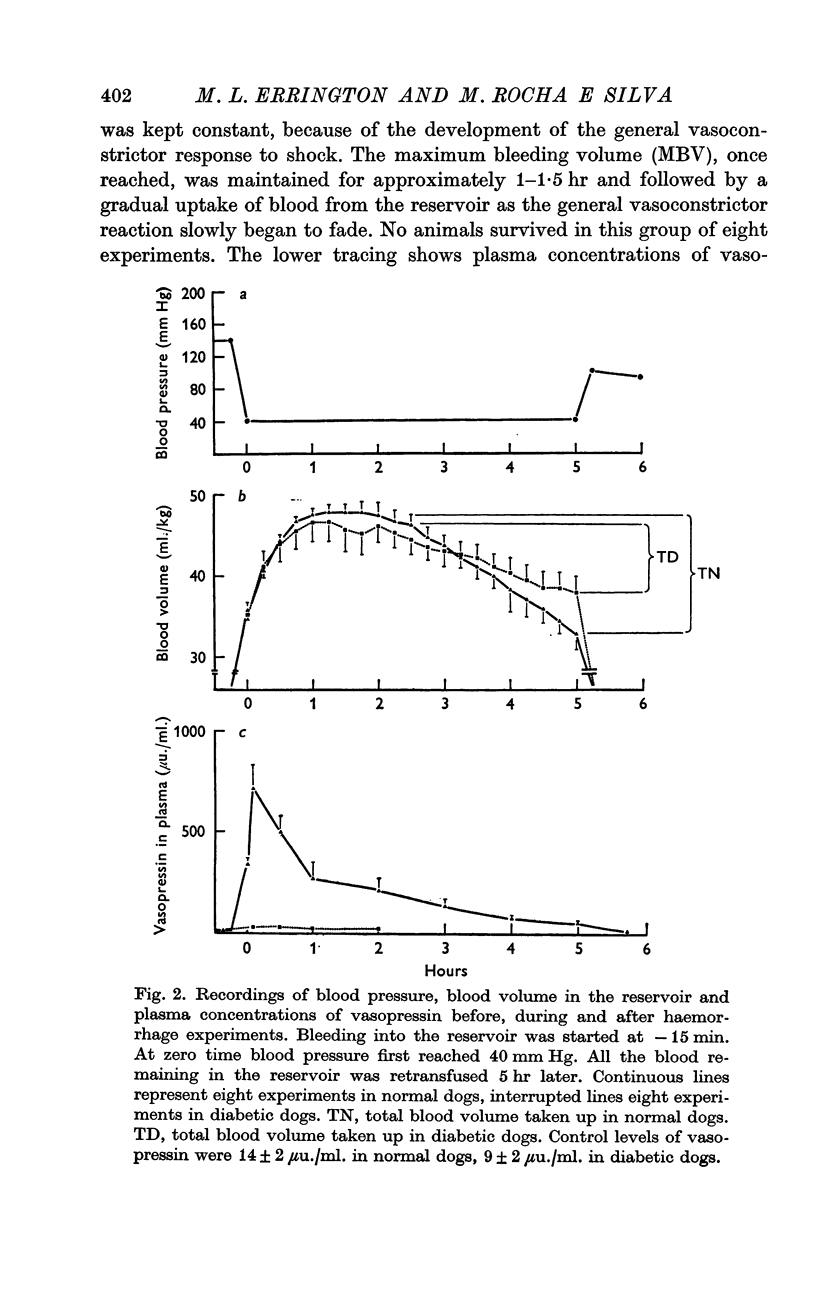
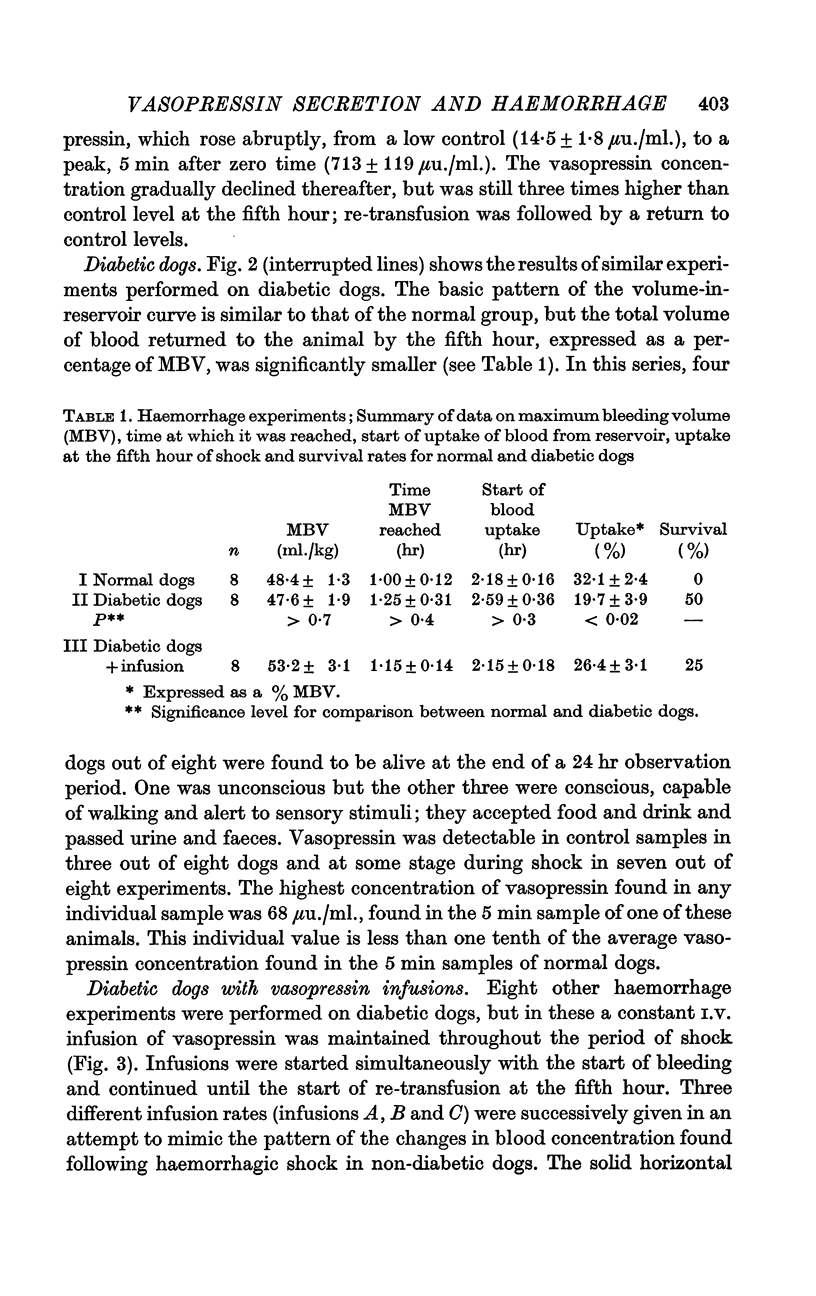
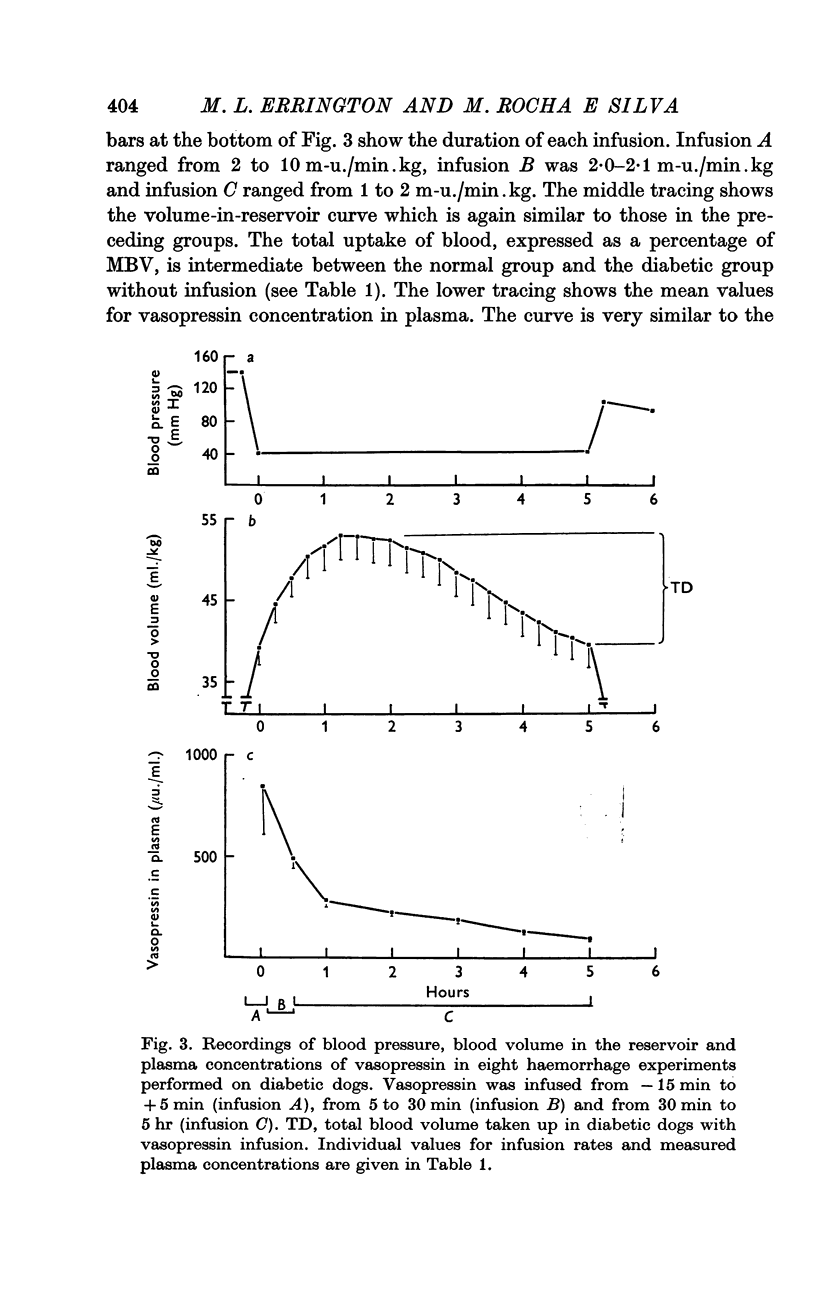
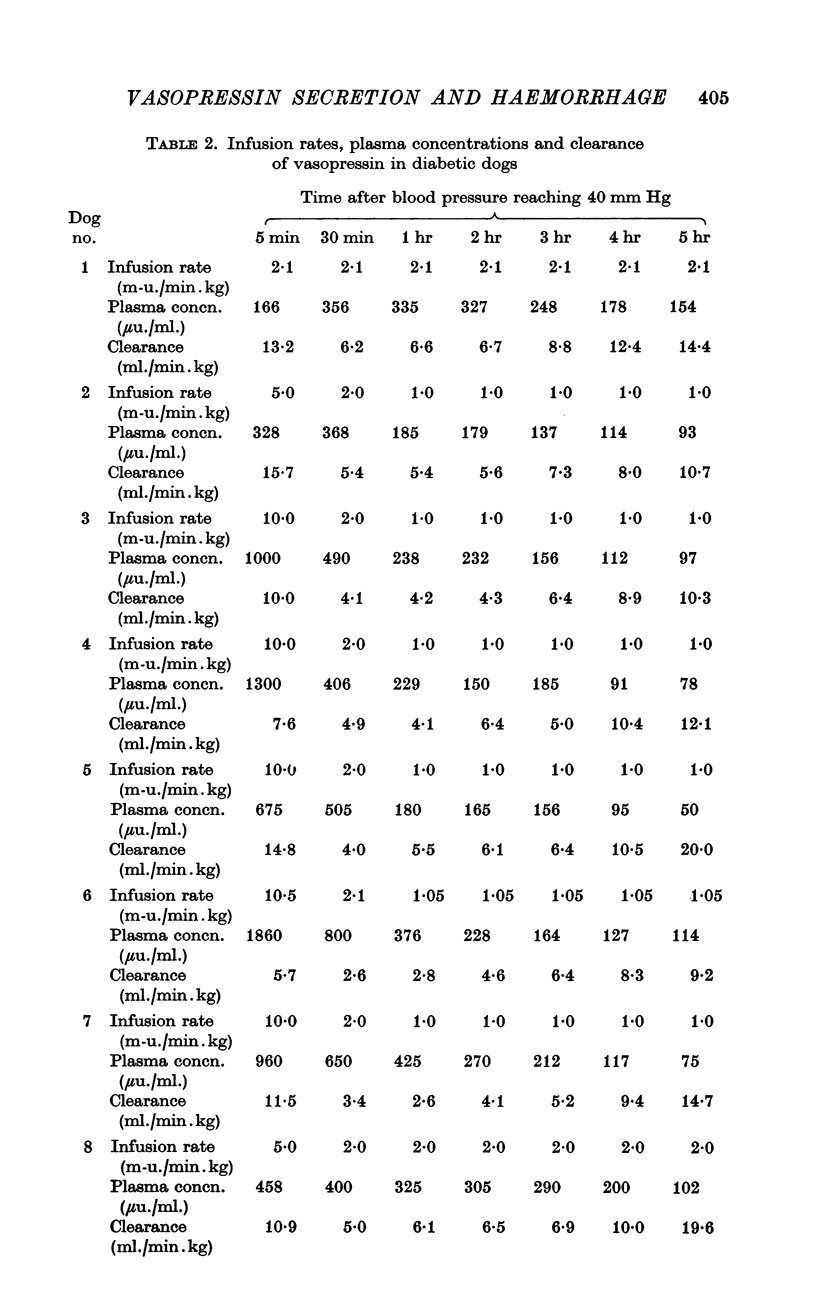
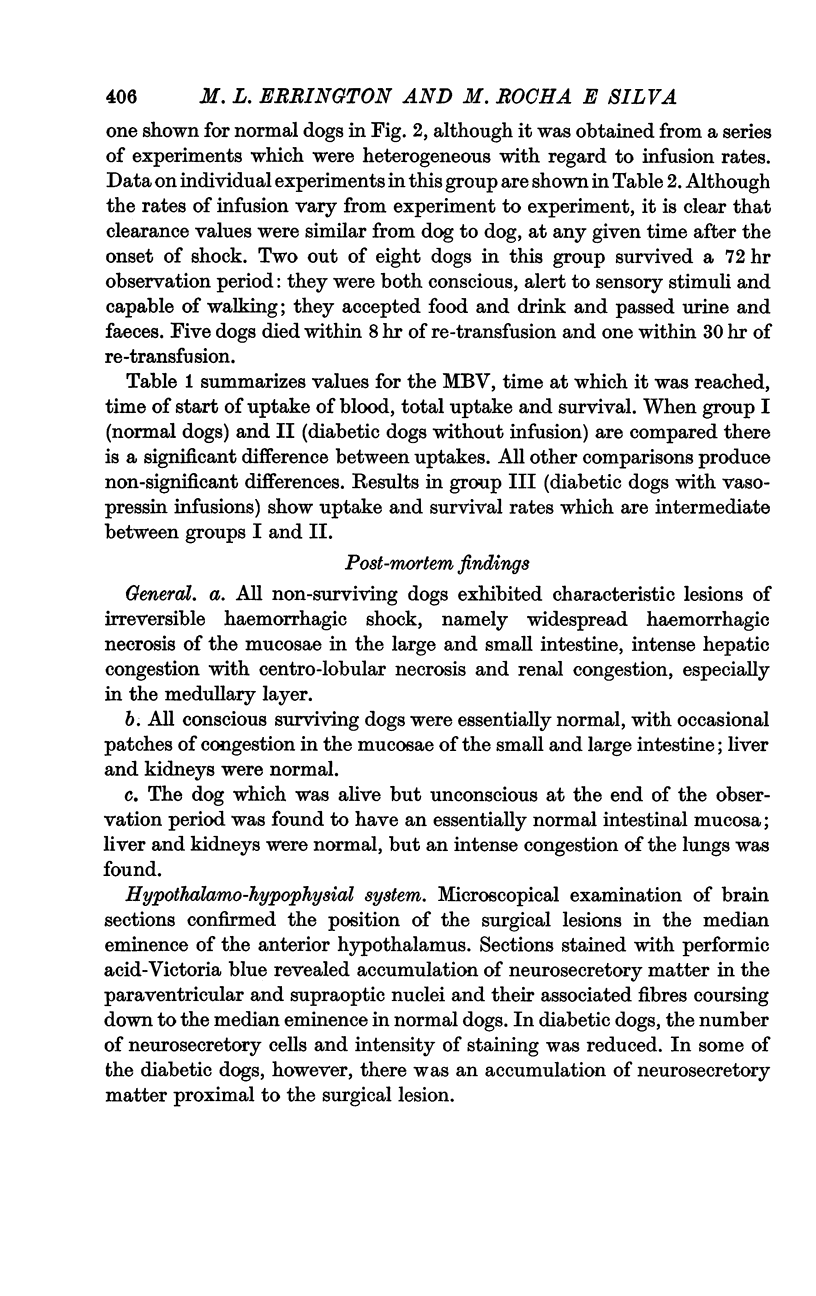
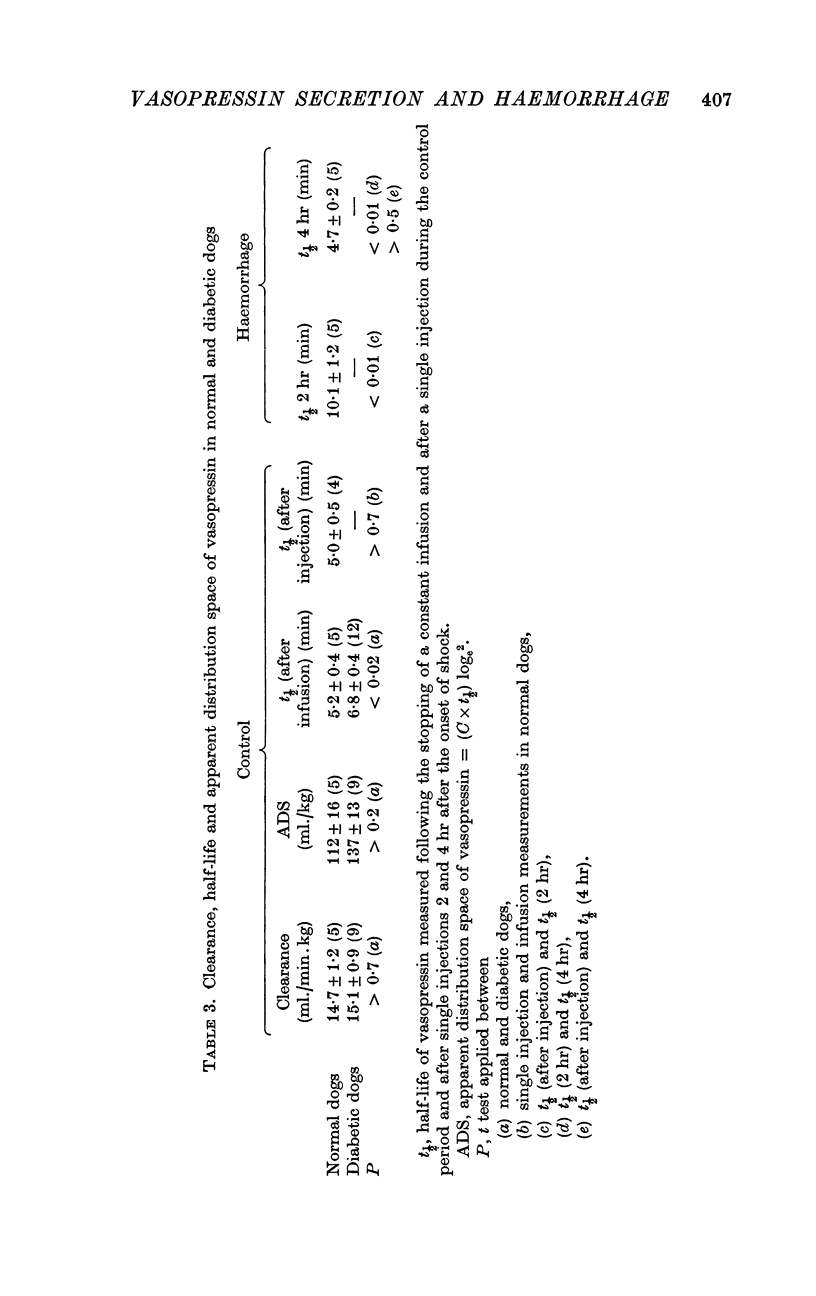
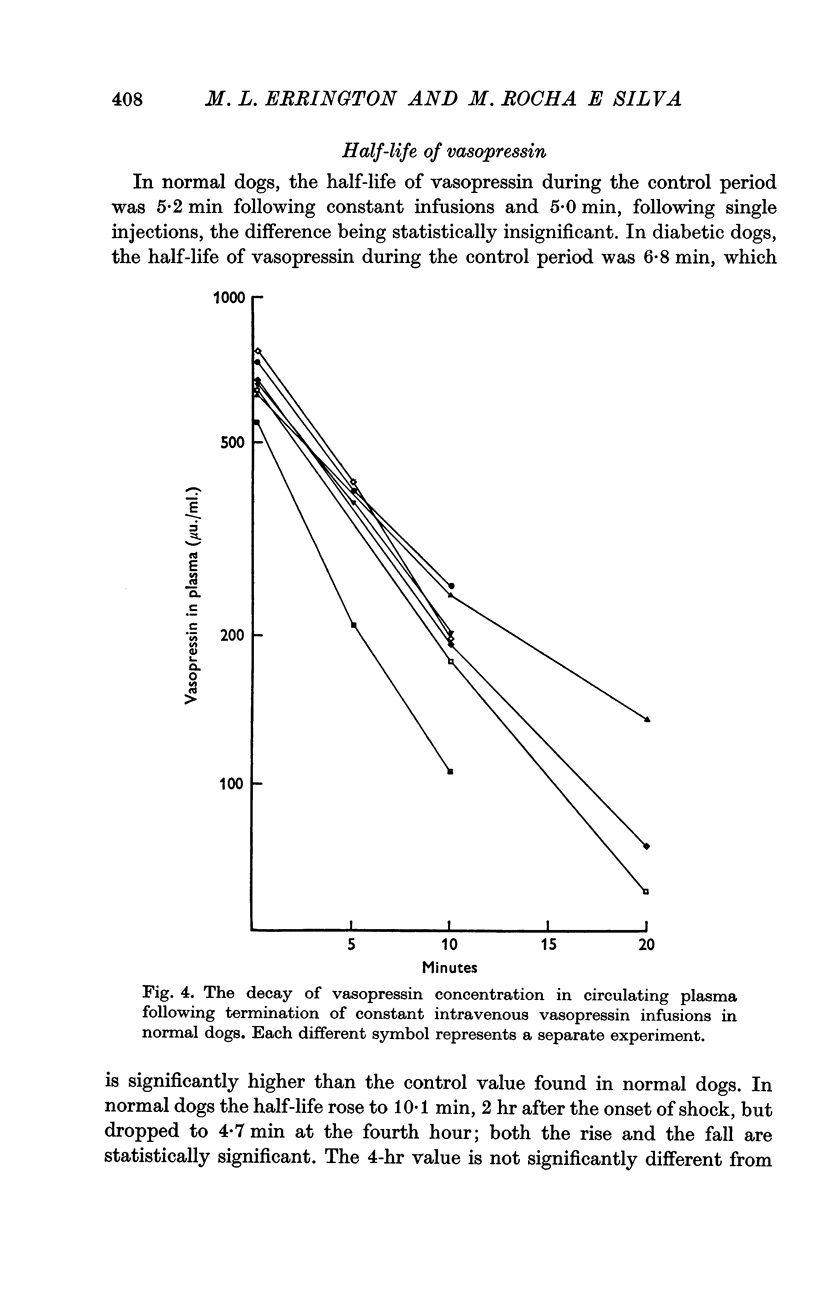
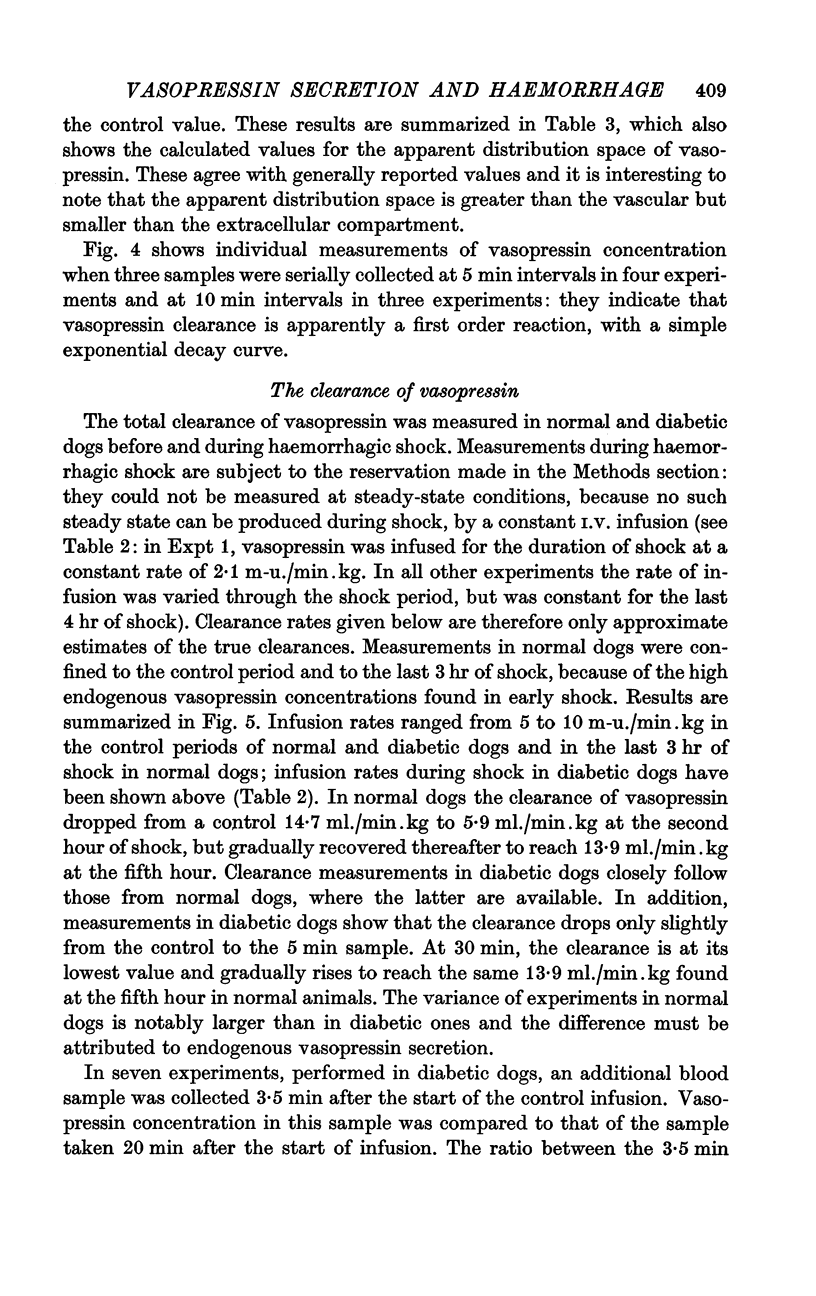
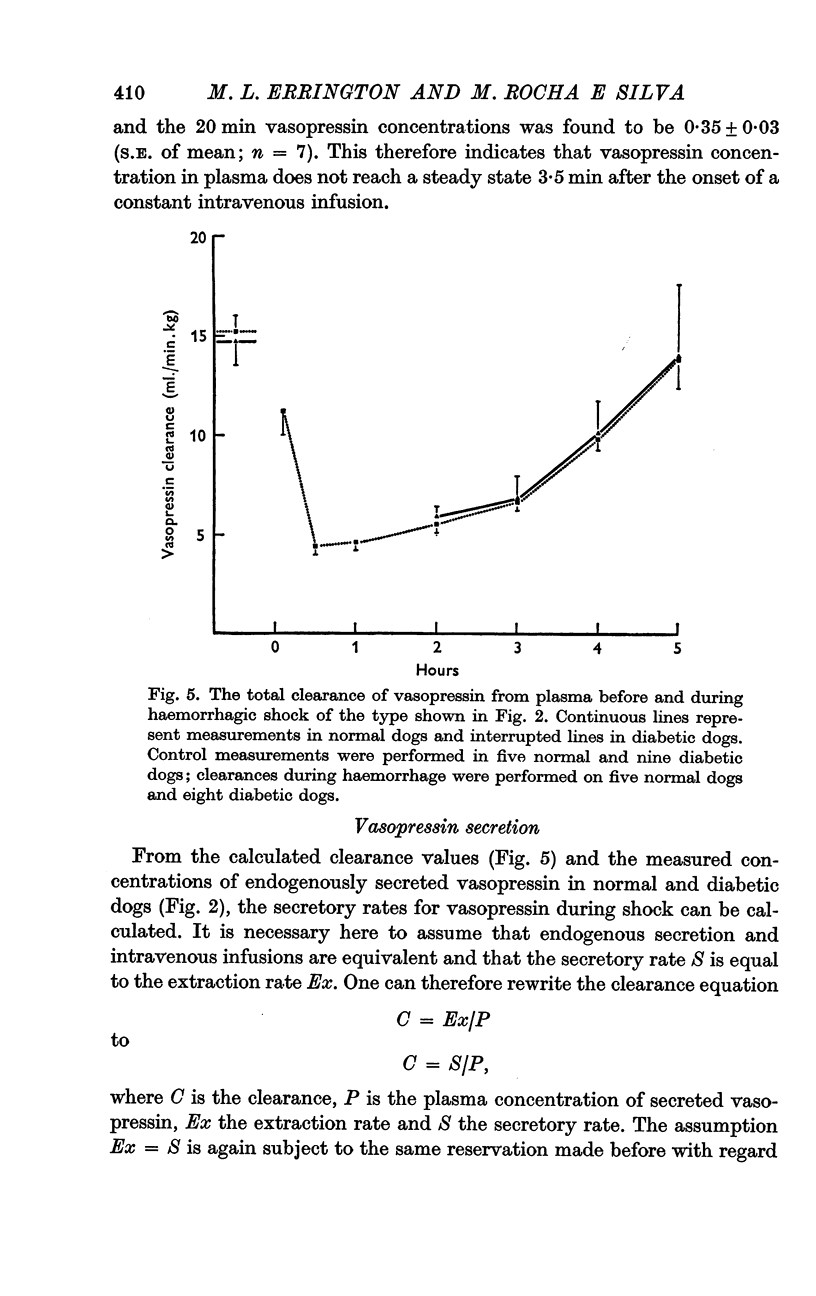
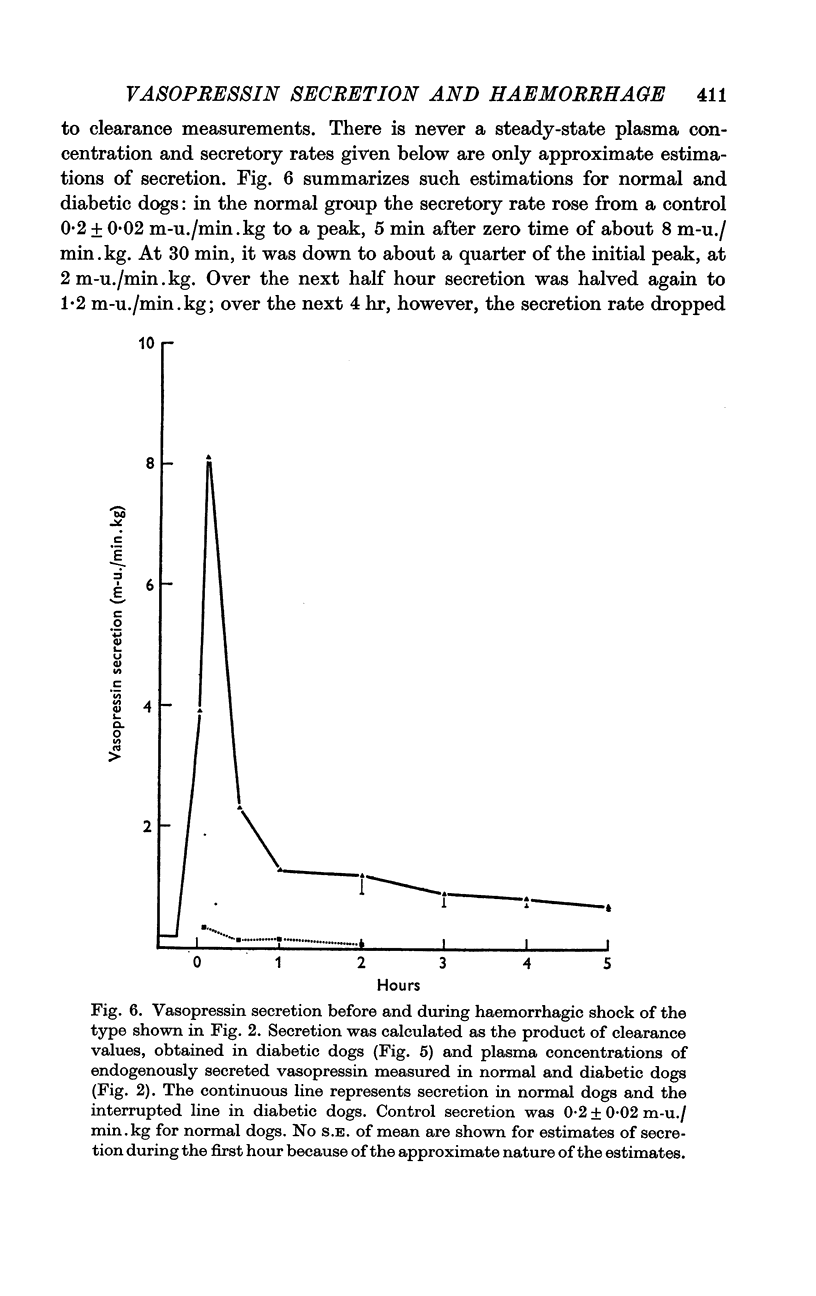
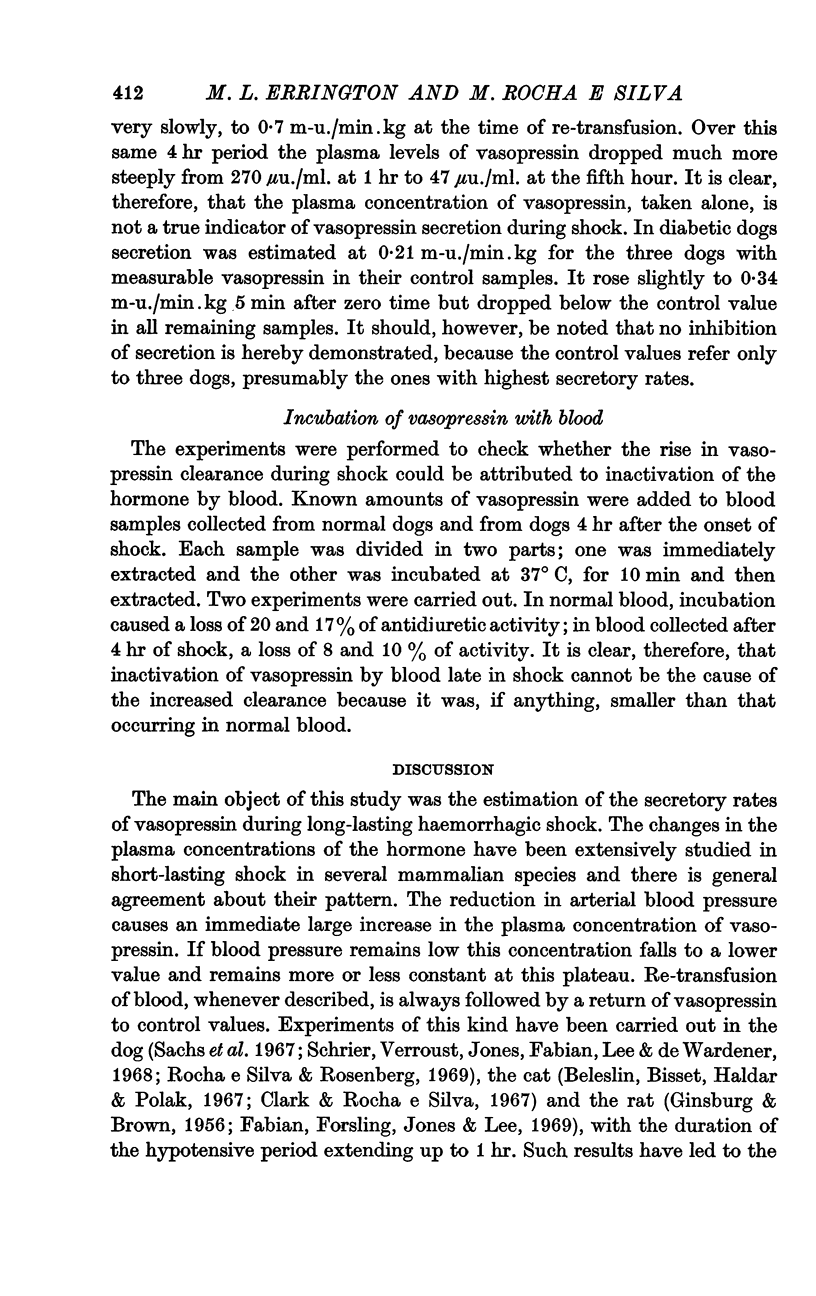
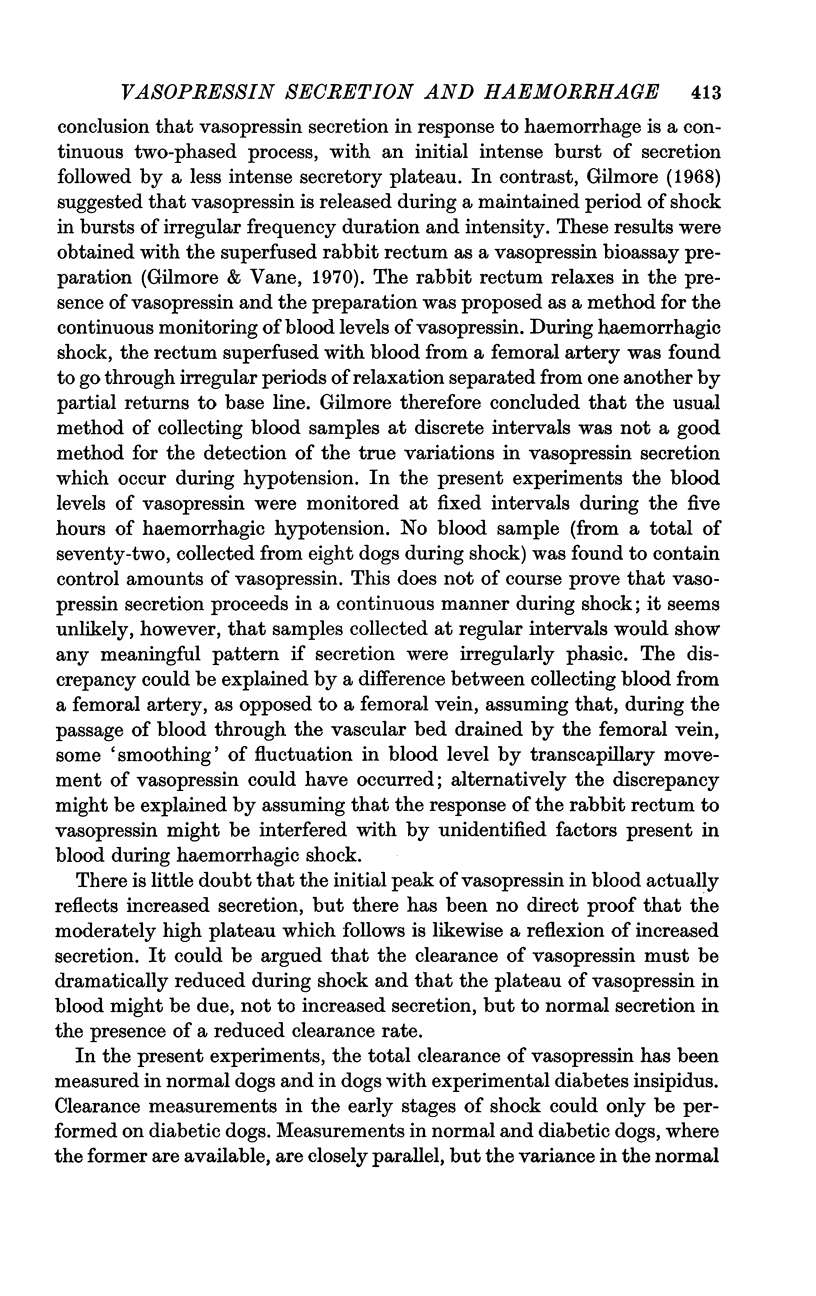
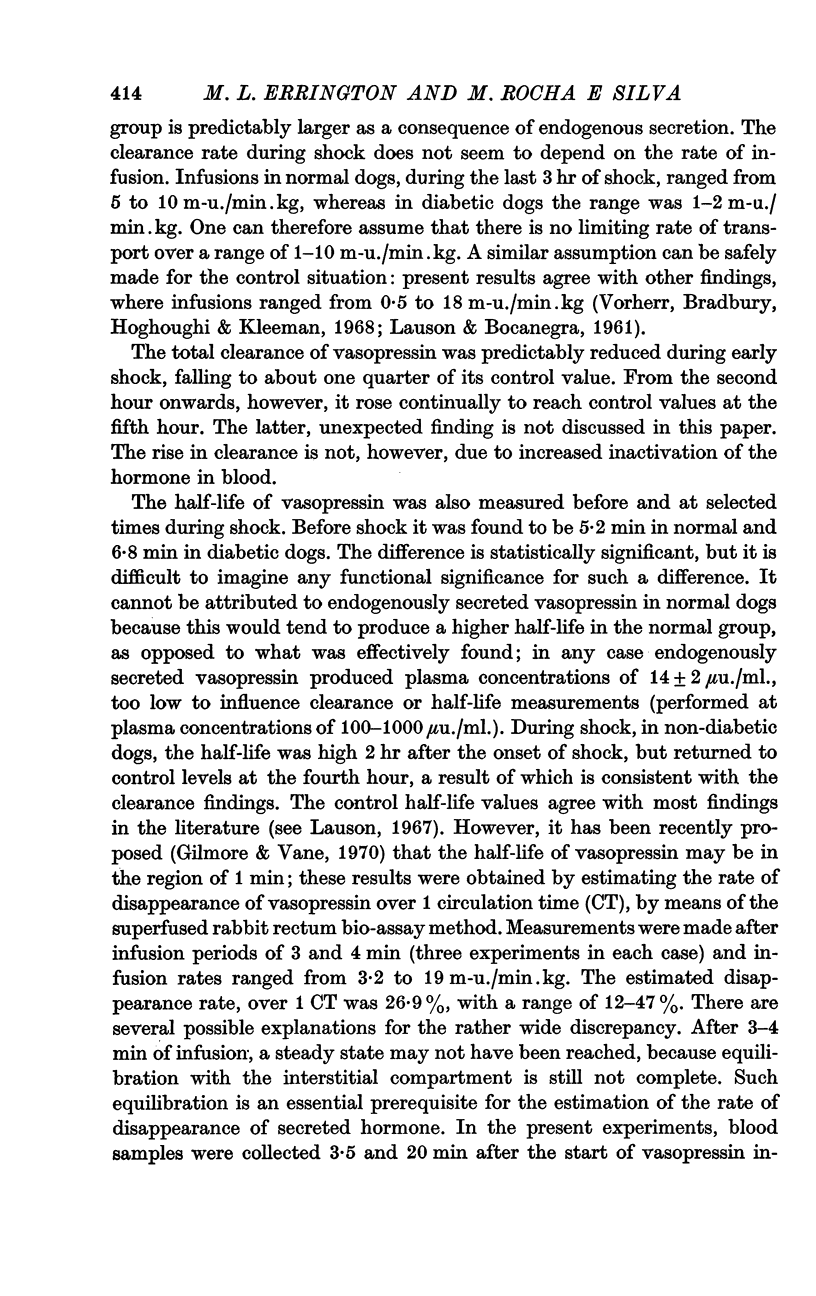
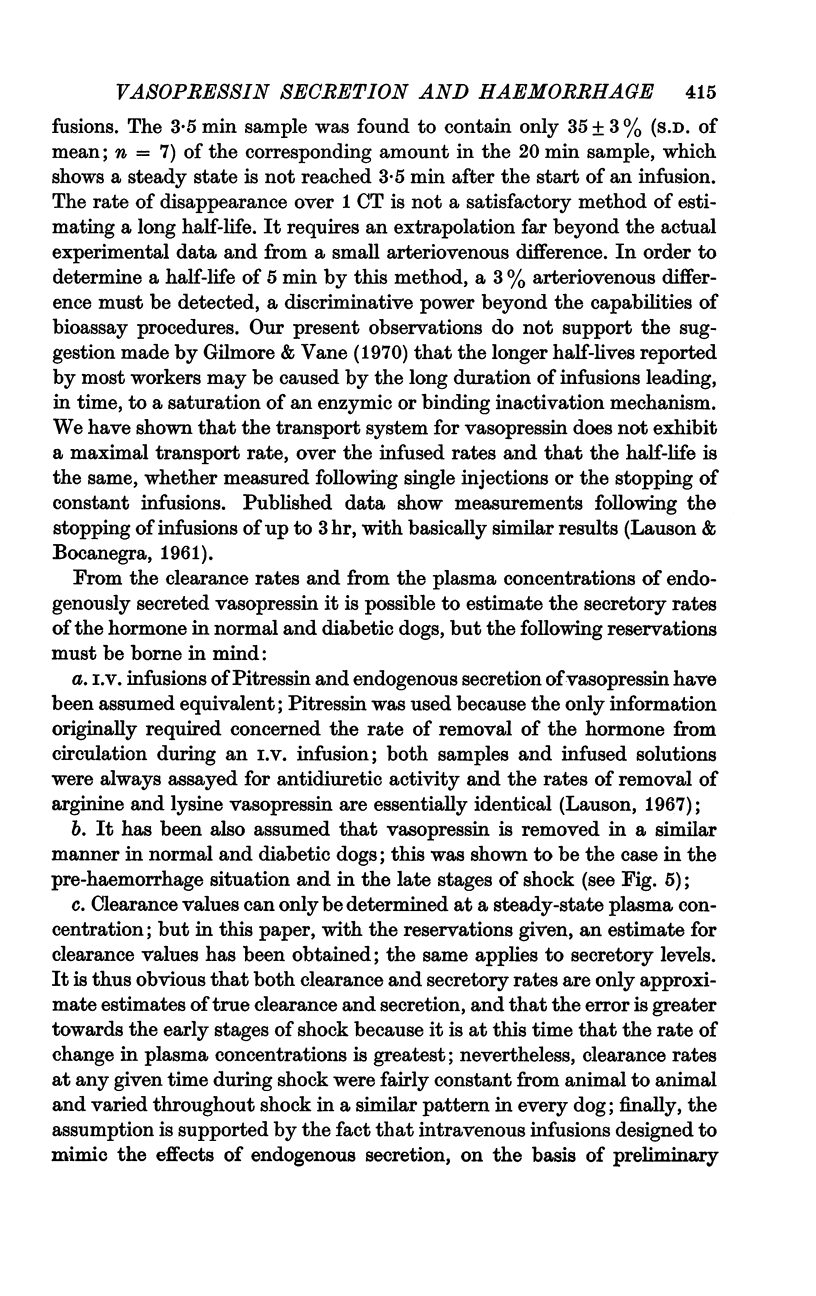
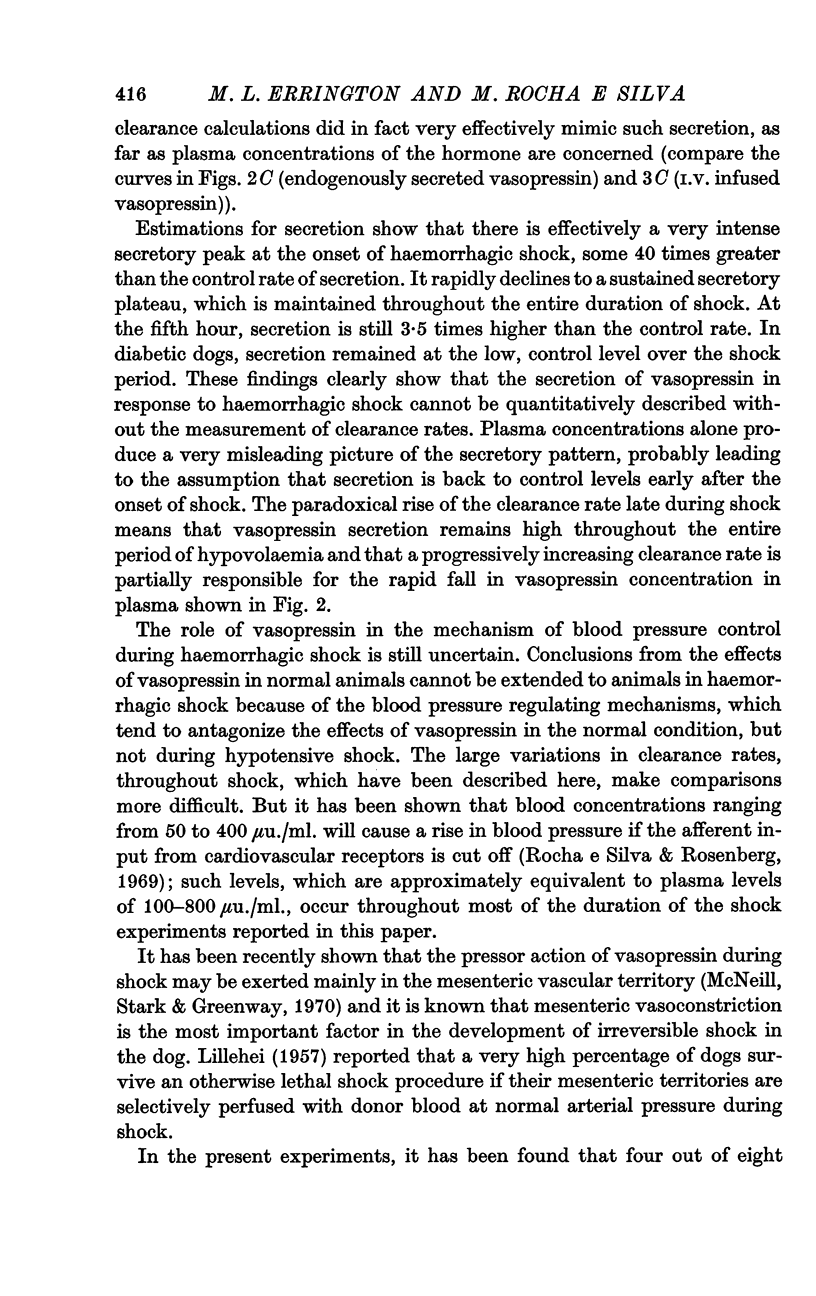
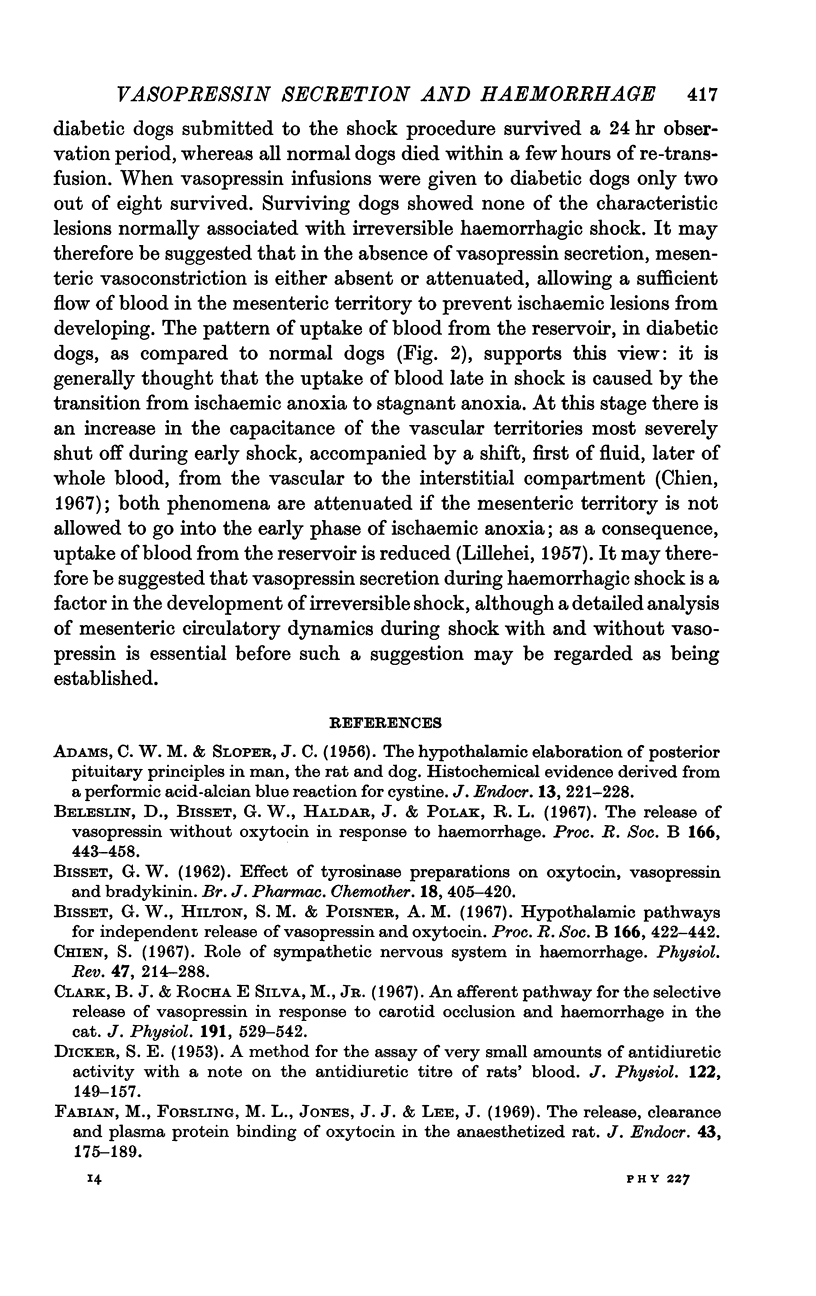
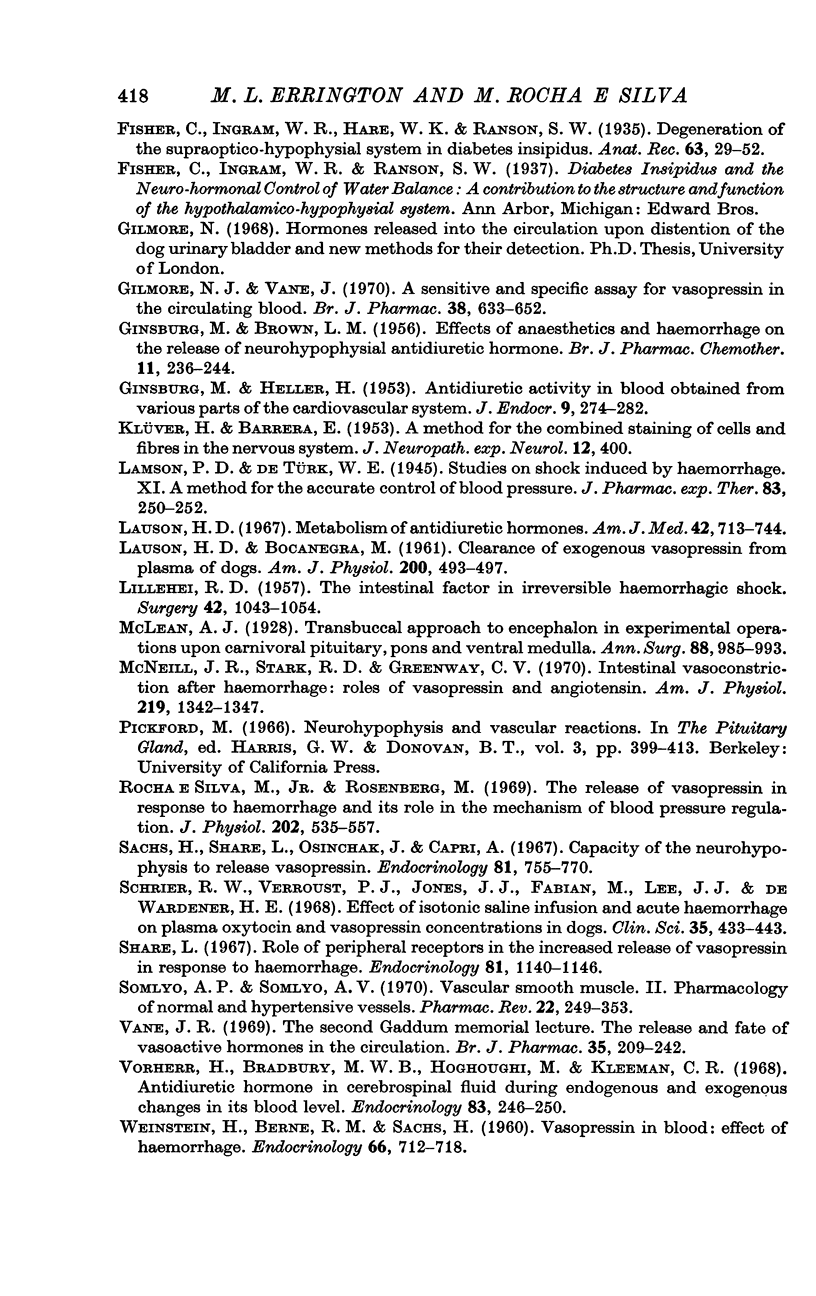
Selected References
These references are in PubMed. This may not be the complete list of references from this article.
- ADAMS C. W., SLOPER J. C. The hypothalamic elaboration of posterior pituitary principles in man, the rat and dog; histochemical evidence derived from a performic acid-Alcian blue reaction for cystine. J Endocrinol. 1956 Apr;13(3):221–228. doi: 10.1677/joe.0.0130221. [DOI] [PubMed] [Google Scholar]
- BISSET G. W. Effect of tyrosinase preparations on oxytocin, vasopressin and bradykinin. Br J Pharmacol Chemother. 1962 Apr;18:405–420. doi: 10.1111/j.1476-5381.1962.tb01420.x. [DOI] [PMC free article] [PubMed] [Google Scholar]
- BROWN L. M., GINSBURG M. Effect of anaesthetics and haemorrhage on the release of neurohypophysial antidiuretic hormone. Br J Pharmacol Chemother. 1956 Sep;11(3):236–244. doi: 10.1111/j.1476-5381.1956.tb01060.x. [DOI] [PMC free article] [PubMed] [Google Scholar]
- Chien S. Role of the sympathetic nervous system in hemorrhage. Physiol Rev. 1967 Apr;47(2):214–288. doi: 10.1152/physrev.1967.47.2.214. [DOI] [PubMed] [Google Scholar]
- Clark B. J., Silva MR Jr E. An afferent pathway for the selective release of vasopressin in response to carotid occlusion and haemorrhage in the cat. J Physiol. 1967 Aug;191(3):529–542. doi: 10.1113/jphysiol.1967.sp008266. [DOI] [PMC free article] [PubMed] [Google Scholar]
- DICKER S. E. A method for the assay of very small amounts of antidiuretic activity with a note on the antidiuretic titre of rat's blood. J Physiol. 1953 Oct;122(1):149–157. doi: 10.1113/jphysiol.1953.sp004986. [DOI] [PMC free article] [PubMed] [Google Scholar]
- Fabian M., Forsling M. L., Jones J. J., Lee J. The release, clearance and plasma protein binding of oxytocin in the anaesthetized rat. J Endocrinol. 1969 Feb;43(2):175–189. doi: 10.1677/joe.0.0430175. [DOI] [PubMed] [Google Scholar]
- GINSBURG M., HELLER H. Antidiuretic activity in blood obtained from various parts of the cardiovascular system. J Endocrinol. 1953 Jul;9(3):274–282. doi: 10.1677/joe.0.0090274. [DOI] [PubMed] [Google Scholar]
- Gilore N. J., Vane J. R. A sensitive and specific assay for vasopressin in the circulating blood. Br J Pharmacol. 1970 Apr;38(4):633–652. doi: 10.1111/j.1476-5381.1970.tb09873.x. [DOI] [PMC free article] [PubMed] [Google Scholar]
- KLUVER H., BARRERA E. A method for the combined staining of cells and fibers in the nervous system. J Neuropathol Exp Neurol. 1953 Oct;12(4):400–403. doi: 10.1097/00005072-195312040-00008. [DOI] [PubMed] [Google Scholar]
- LAUSON H. D., BOCANEGRA M. Clearance of exogenous vasopressin from plasma of dogs. Am J Physiol. 1961 Mar;200:493–497. doi: 10.1152/ajplegacy.1961.200.3.493. [DOI] [PubMed] [Google Scholar]
- LILLEHEI R. C. The intestinal factor in irreversible hemorrhagic shock. Surgery. 1957 Dec;42(6):1043–1054. [PubMed] [Google Scholar]
- Lauson H. D. Metabolism of antidiuretic hormones. Am J Med. 1967 May;42(5):713–744. doi: 10.1016/0002-9343(67)90091-5. [DOI] [PubMed] [Google Scholar]
- McLean A. J. TRANSBUCCAL APPROACH TO THE ENCEPHALON: IN EXPERIMENTAL OPERATIONS UPON CARNIVORAL PITUITARY, PONS, AND VENTRAL MEDULLA. Ann Surg. 1928 Dec;88(6):985–993. doi: 10.1097/00000658-192812000-00003. [DOI] [PMC free article] [PubMed] [Google Scholar]
- McNeill J. R., Stark R. D., Greenway C. V. Intestinal vasoconstriction after hemorrhage: roles of vasopressin and angiotensin. Am J Physiol. 1970 Nov;219(5):1342–1347. doi: 10.1152/ajplegacy.1970.219.5.1342. [DOI] [PubMed] [Google Scholar]
- Rocha E Silva M., Jr, Rosenberg M. The release of vasopressin in response to haemorrhage and its role in the mechanism of blood pressure regulation. J Physiol. 1969 Jun;202(3):535–557. doi: 10.1113/jphysiol.1969.sp008826. [DOI] [PMC free article] [PubMed] [Google Scholar]
- Sachs H., Share L., Osinchak J., Carpi A. Capacity of the neurohypophysis to release vasopressin. Endocrinology. 1967 Oct;81(4):755–770. doi: 10.1210/endo-81-4-755. [DOI] [PubMed] [Google Scholar]
- Schrier R. W., Verroust P. J., Jones J. J., Fabian M., Lee J., De Wardener H. E. Effect of isotonic saline infusion and acute haemorrhage on plasma oxytocin and vasopressin concentrations in dogs. Clin Sci. 1968 Dec;35(3):433–443. [PubMed] [Google Scholar]
- Share L. Rol of peripheral receptors in the increased release of vasopressin in response to hemorrhage. Endocrinology. 1967 Nov;81(5):1140–1146. doi: 10.1210/endo-81-5-1140. [DOI] [PubMed] [Google Scholar]
- Somlyo A. P., Somlyo A. V. Vascular smooth muscle. II. Pharmacology of normal and hypotensive vessels. Pharmacol Rev. 1970 Jun;22(2):249–353. [PubMed] [Google Scholar]
- Vane J. R. The release and fate of vaso-active hormones in the circulation. Br J Pharmacol. 1969 Feb;35(2):209–242. doi: 10.1111/j.1476-5381.1969.tb07982.x. [DOI] [PMC free article] [PubMed] [Google Scholar]
- Vorherr H., Bradbury M. W., Hoghoughi M., Kleeman C. R. Antidiuretic hormone in cerebrospinal fluid during endogenous and exogenous changes in its blood level. Endocrinology. 1968 Aug;83(2):246–250. doi: 10.1210/endo-83-2-246. [DOI] [PubMed] [Google Scholar]
- WEINSTEIN H., BERNE R. M., SACHS H. Vasopressin in blood: effect of hemorrhage. Endocrinology. 1960 May;66:712–718. doi: 10.1210/endo-66-5-712. [DOI] [PubMed] [Google Scholar]


